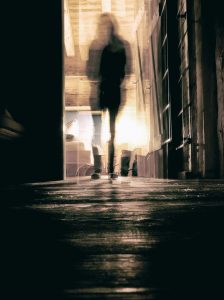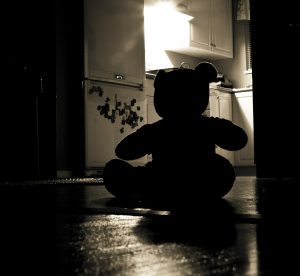Stephen Volk had a great idea. Inspired by H.G. Wells and his infamous alien radio broadcast, Volk pitched the idea of a series centering around a paranormal investigation crew who tours a haunted house. The BBC cut it down to just one episode – the climactic haunted house encounter – and set it to air on Halloween. What made “Ghostwatch” unique was that it would be filmed like a documentary and feature well-known BBC news presenters. What could go wrong?

The spirit “Pipes” terrorized the family on “Ghostwatch”
Everything was filmed beforehand, but to television viewers, it would appear live. On Halloween night, 1992, “Ghostwatch” aired. Two presenters went to the house to cover the story, while Michael Parkinson – a trusted newsman – would remain in a studio. At the haunted house, viewers met the Early family, which consisted of a single mom and her two daughters. They reported strange and frightening occurrences, like the sound of cats, breaking dishware, and even scratches. They blamed “Pipes,” a poltergeist who would not leave them alone. The first half of the show was nothing too scary, and coverage from the house was balanced with “live” calls from viewers (who were actors) and an interview with a skeptic.
However, the second half kicked it up a few notches. “Pipes” was identified as a deceased man who in life had been haunted by “Mother Seddons,” a serial killer from the 19th century. He began to gain power, so by the end of the show, the two shaken reporters informed viewers they had all accidentally participated in a national seance that emboldened Pipes. Pipes promptly dragged one of the reporters off-screen and then possessed Michael Parkinson, saying he had taken control of the TV station. The end.

Children were especially traumatized by “Ghostwatch”
The network had a few switchboard operators to take calls after the show, but they were soon overwhelmed by 30,000 calls in the hour after the program ended. People were terrified. While “Ghostwatch” had a disclaimer at the beginning, had a time slot reserved for fictional shows, and was listed as a drama in a magazine with a full cast list, many people watched believing it was all totally real. The response was so unexpected and horrified that within mere hours of “Ghostwatch,” the BBC issued a press release to explain that the show was all fiction. In the following months, doctors began reporting more cases of PTSD in kids. The reporter who had su pposedly been killed by Pipes made several appearances on kids’ shows to show she had not been hurt, and Volk – the mastermind behind it all – apologized.
The most tragic event to follow “Ghostwatch” was the death of a mentally-challenged teenager. After watching the show, he became increasingly upset and believed ghosts were real. He ended up taking his own life. His parents blamed the BBC, and the Broadcasting Standards Council ruled that the show had not been labeled properly as fictional. “Ghostwatch” never aired again.
In 2002, “Ghostwatch” was released on DVD,and in 2012, a documentary titled, “Ghostwatch: Behind the Curtains,” came out. Fans hold special screenings on Halloween. The fake supernatural documentary has become its own genre. “The Blair Witch Project” and the “Paranormal Activity” series are all framed as “true.” The alien film, “The Fourth Kind,” went so far as to make trailers featuring star actress Milla Jovovich saying outright that she was playing a real person. This movie generated a lot of confusion, but some quick Google searches revealed none of it was true. In 1992, however, people didn’t have a fast way to find out that “Ghostwatch” wasn’t real.
You can get “Ghostwatch” on DVD on Amazon, or watch it with a Shudder subscription.
Curious about other big paranormal hoaxes? Click here.




